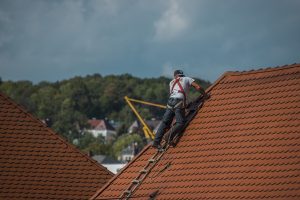 Roofing can be a competitive and rewarding field, and years of hard work can help contractors establish a strong customer base and reputation. Roofing contractors invest their expertise, time and energy to build or repair roofs that will stand the test of time. However, owning a roofing contractor business can be physically and mentally demanding. And it’s a constant challenge to deliver exceptional service while maintaining profitability.
Roofing can be a competitive and rewarding field, and years of hard work can help contractors establish a strong customer base and reputation. Roofing contractors invest their expertise, time and energy to build or repair roofs that will stand the test of time. However, owning a roofing contractor business can be physically and mentally demanding. And it’s a constant challenge to deliver exceptional service while maintaining profitability.
These challenges are magnified when you consider that risks related to property damage, equipment breakdowns, environmental factors, inland marine and crime must also be addressed. The list below provides an overview of these risks and more. This can help you identify potential blind spots in your risk management and insurance programs.
Property Exposures
While most incidents that occur on a customer’s property would be covered under a general liability policy, property exposures are still present at the contractor’s office and workshop. Exposures can come from malfunctioning electrical equipment, flammable materials, weather and natural disasters. Fire damage may be a particular concern if the contractor stores roofing materials or heats bitumen on the premises.
Bodily Injury Exposures
No matter how careful your employees are, accidents can and do happen. These accidents create a significant bodily injury exposure. Slips, trips and falls are common hazards in roofing operations. What’s more, because roofers work at heights with tools, people below are at risk of injury from falling objects. In the event of a bodily injury to an employee, client or third party, a roofing contractor could be forced to pay for medical costs, emergency care, doctor’s visits and legal expenses.
Automobile Exposures
The vast majority of roofing contractors depend on employees to operate vehicles for the company, creating automobile exposures in the process. While important for daily operations (e.g., driving from job site to job site or transporting tools), the use of a vehicle can lead to potential accidents and major insurance claims. And, if you allow employees to use their own vehicles for work, standard commercial auto policies are often not enough.
Completed Operations Exposures
Once a job has been completed, roofing contractors can be held liable if their work product causes bodily injury or property damage. While claims of smaller problems can often be resolved with a repair, larger issues may result in legal action. Completed operations coverage can help protect a contractor in the event of such a claim.
Equipment Breakdown Exposures
Roofing contractors depend on a variety of different equipment to complete work on a roof. Potentially creating significant equipment breakdown exposures as a result. Moreover, roofing contractors can experience business interruptions or even lose contracts as a result of an equipment breakdown.
Inland Marine Exposures
Roofing contractors regularly transport equipment, tools and supplies to and from worksites. As such, any property that’s unique or valuable in transit, in your temporary care, stored at fixed (but movable) locations or used to transfer information represents inland marine exposures. Materials and tools can be damaged in transit from shifting loads or traffic collisions; at the worksite from collision, being dropped or poor weather conditions; or lost from theft, potentially creating costly losses.
Environmental Liabilities
The disposal of old roofing materials, waste bitumen and other hazardous materials presents potential environmental liabilities, as these materials can create pollution. Environmental incidents are particularly concerning because they can cause harm to the surrounding community, involve costly cleanup and often cause damage to a business’s reputation.
Business Interruption
Continuity is critical for any business. And there are few things more important than continuous revenue and a steady cash flow. A single business interruption can be costly for roofing contractors and may even lead to serious reputation damage or long-term closures. Common interruptions for roofing contractors stem from natural disasters, fires, equipment breakdown and loss of materials.
Crime Exposures
Roofing contractors face several crime exposures. Particularly if valuable equipment or tools are left unattended at the worksite, which may attract thieves or vandals. Thieves (including your employees) can rob an office or worksite at any time, targeting cash or valuable supplies. What’s more, with worksite locations changing on a regular basis, the level of risk a roofing contractor faces is in constant flux.
Workers’ Compensation
Any time an employee is injured on the job, your organization could be subjected to expensive workers’ compensation claims. Common sources of on-the-job accidents for roofing contractors include:
- falls from heights (e.g., roofs and scaffolds)
- heat stress
- injuries related to equipment use
- slips, trips, falls
- musculoskeletal injuries caused by repetitive tasks.
Normal, everyday tasks related to laying shingles or climbing ladders can lead to accidents and, in turn, increased costs for your business.
For More Information
While the proper risk management practices can reduce certain exposures, no system is 100% effective in ensuring an incident-free workplace. As a result, it’s all the more crucial to work with a qualified insurance broker to not only assess you exposures, but secure the appropriate coverage as well. To learn more, contact Rinehart, Walters & Danner today.
Click Here to learn more about business insurance.